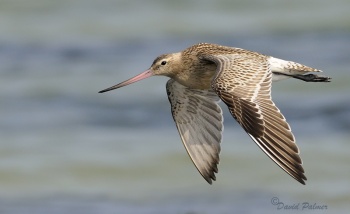
- Limosa lapponica
Identification
In Breeding plumage: belly rufous with no or little barring, and dark bill slightly upturned.
In Non-breeding plumage: back gray with streaking, upturned bill bicolored, and long supercilium extending back past eye.
In Juvenile plumage: back patterned with white and gray, upturned bill bicolored, and long supercilium extending back past eye.
Similar Species
Black-tailed Godwit, which has a straighter bill; and from Eurasian Curlew and Whimbrel which both have down-curved beaks.
Distribution

- Breeds in northern Palearctic: extreme northern Scandinavia (Norway, Finland, limited in Sweden), Arctic Russia (Kola Peninsula eastwards), and Alaska.
- Migration most active March-April (south to north), and August-October (north to south). Seen regularly en route through the Baltic Sea, North Sea, and Atlantic coasts. Rare to find any distance inland.
- Winters to southern Africa and Australasia. A varying concentration of individuals will occur year-round in this non-breeding range.
Vagrancy
Vagrant north to Svalbard, Iceland and the Faroe Islands; Cyprus and eastern Mediterranean countries; Madeira and the Azores. Casual vagrant in North America on both coasts.
Taxonomy
Some authorities show 4 subspecies[2].
Subspecies[1]
- L. l. lapponica:
- L. l. menzbieri:
- L. l. baueri:
- Bar-tailed Godwit (Siberian): North-eastern Siberia to western Alaska; winters China to New Zealand
Habitat
- Coastal estuaries and sheltered sandy shores.
- Arctic breeding habitat is lowland tundra; sometimes in upland areas and among trees.
Behaviour
Very gregarious in the winter, forming huge flocks with other waders at the water's edge.
Diet
The diet includes worms, snails and insects.
Breeding
It nests on the ground, usually in short vegetation, in marshy areas above the tree-line.
Vocalisation
<flashmp3>Limosa lapponica (song).mp3</flashmp3>
Listen in an external program
References
- Clements, JF. 2008. The Clements Checklist of Birds of the World. 6th ed., with updates to December 2008. Ithaca: Cornell Univ. Press. ISBN 978-0801445019.
- Avibase
- Collins Pocket Guide to British Birds 1966
- Collins Field Guide 5th Edition
- Collins Bird Guide ISBN 0 00 219728 6
Recommended Citation
- BirdForum Opus contributors. (2024) Bar-tailed Godwit. In: BirdForum, the forum for wild birds and birding. Retrieved 3 May 2024 from https://www.birdforum.net/opus/Bar-tailed_Godwit




